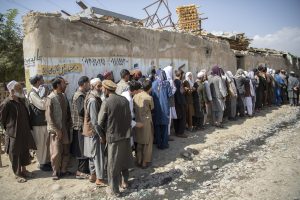For the first time in decades, Afghanistan has an opportunity for peace. The United States’ agreement to withdraw its troops and the negotiations between the Afghanistan government and Taliban have set the stage for the end of a long and bitter conflict.
If the talks are successful, the Afghan people’s enduring hope for a better future may at last be realized. If peace is secured, more children can go to school. Greater security means health facilities can operate without fear of attacks. Roads can open up for trade, allowing farmers to get their produce to market. Investment can generate more and better jobs for adults. People may no longer feel their only choice is to leave their home for a safer place.
But just as peace appears to be within the nation’s grasp, COVID-19 has imposed a cruel twist of fate, ripping its way through communities that have withstood brutal wars, harsh weather and withering poverty.
Nearly every country in the world has struggled to contain the coronavirus. But Afghanistan is particularly vulnerable. The pandemic has sucker-punched a nation whose economy, infrastructure and population had already been worn ragged.
Two-thirds of the population live more than two hours from the nearest health facility. Most people live in extended households, making social distancing practically impossible.
Afghan government figures have confirmed nearly 40,000 COVID-19 cases, but a random sample by the World Health Organization and Johns Hopkins University in early August suggested that the true figure could be as high as 10 million people – almost one-third of the population.
A serious drought in 2018/19 and annual floods had already threatened food security. Now, the virus is pushing millions deeper into poverty and hunger, further compounding the public health dimension of the crisis.
Afghanistan’s economy is forecast to shrink by 7.4 percent this year, according to the World Bank. Four out of five Afghan workers are in the informal sector – taxi drivers, shopkeepers, domestic workers, day labourers. They have been among the hardest hit.
When Afghanistan’s first case of COVID-19 was reported in the western city of Herat in February, the impact on local livelihoods was immediate and devastating.
Overnight, Gulzada, a single mother with four children, lost her job as a household-helper in Herat.
“People were afraid to have strangers in their house because of the virus,” she explained.
The 6,000 Afghani ($80) cash transfer that she received from the World Food Programme (WFP) brought some relief, particularly as food prices have risen sharply. But to get her life back on track, Gulzada, like hundreds of thousands of fellow Afghans hit hard by the pandemic, needs more support.
“If school starts again, I do not know how I will pay for the education of my children,” she said. “I can either buy food or pay for their education. I cannot afford both.”
Tragically, Gulzada’s story is typical of the crisis facing many ordinary Afghans.
About 14 million Afghans, out of a total population of 38 million people, now need humanitarian assistance. That is 45 percent higher than at the beginning of this year, before COVID-19 arrived.
Besides people’s health and livelihoods, the virus also threatens the fragile hopes for peace.
Peace is by far the most important step to lasting change in Afghanistan. But real peace – the type that lasts – is about much more than the absence of guns and explosive devices.
For peace to endure, ordinary Afghans need to believe they will have enough food, an education, a decent job, a brighter future. A reason not to take up arms.
The Afghan government has stepped up, implementing massive public health and social welfare measures to help its people absorb this latest setback.
Complementing this, WFP has also expanded its response to cover the food needs of 10 million people, 3 million more than originally planned for this year.
But time is now the enemy. Winter is coming and food assistance must arrive before snow closes the mountain passes. This year, food assistance is even more likely to be the only source of nutrition for remote communities until the spring.
If the people of Afghanistan are to finally enjoy the dividends of peace, they need to survive winter, COVID-19 and its economic fallout. Their desire for a better life – one in which they have access to education, health care, jobs and opportunities – deserves to become a reality. International support is needed so the conditions for meaningful peace can take root.
COVID-19 is claiming lives and livelihoods around the world. Governments and companies everywhere are reassessing their spending, including on humanitarian and development assistance. It would be tragic if Afghanistan’s chance for lasting peace and prosperity were to fall victim to the virus too.
John Aylieff is World Food Programme regional director for Asia and the Pacific.

































